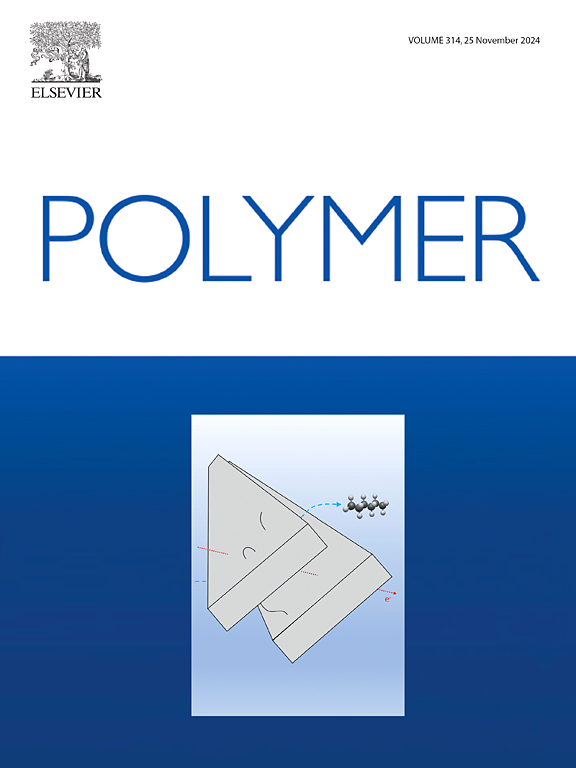"High-performance mixed matrix membranes with very-high ZIF-8 loading for efficient CO2 capture"
IF 4.5
2区 化学
Q2 POLYMER SCIENCE
引用次数: 0
Abstract
Addressing the challenges of climate change and global warming, membrane separation processes are considered as innovative industrial solutions. Among different membrane materials, mixed matrix membranes are very promising for CO2 capture. In this work, a segmented poly(urea-imide) with high poly(ethylene oxide) content (70 % wt) was selected as a new rubbery polymer matrix and was doped with the metal organic framework ZIF-8. The new polymer matrix and the optimization of the “priming” method enabled to obtain very high ZIF-8 loadings up to 70 % vol. Various physicochemical methods were used to study the influence of filler/polymer interactions on the membrane's morphology. The CO2 and N2 permeation properties were evaluated by time-lag measurements for both pure gases under standard conditions for CO2 post-combustion capture (2 bar and 35 °C). Very promising membrane performances were achieved for the highest ZIF-8 loading (70 % vol) with a strong increase of the CO2 permeability PCO2 = 471 Barrer (x 8.5 compared to the pristine polymer) and a relatively high ideal selectivity αCO2/N2 = 30.2. The modeling of the MMM's performances was successfully achieved with Maxwell model up to high ZIF-8 content (60 % vol).


高ZIF-8负载的高效CO2捕集高性能混合基质膜
为了应对气候变化和全球变暖的挑战,膜分离工艺被认为是一种创新的工业解决方案。在不同的膜材料中,混合基质膜在CO2捕集方面是非常有前途的。本研究选择了一种高聚环氧乙烷含量(70% wt)的聚脲酰亚胺作为新型橡胶聚合物基体,并掺杂了金属有机骨架ZIF-8。新的聚合物基质和“启动”方法的优化使得ZIF-8的负载达到了70%。各种物理化学方法被用来研究填料/聚合物相互作用对膜形态的影响。在二氧化碳燃烧后捕获的标准条件下(2 bar和35°C),通过测量纯气体的CO2和N2渗透特性来评估。在ZIF-8负载最高(70% vol)的情况下,膜的性能非常有希望,CO2渗透率PCO2 = 471 Barrer(与原始聚合物相比,x 8.5)大幅增加,αCO2/N2 = 30.2的理想选择性相对较高。在ZIF-8含量最高(60% vol)的情况下,利用Maxwell模型成功模拟了MMM的性能。
本文章由计算机程序翻译,如有差异,请以英文原文为准。
求助全文
约1分钟内获得全文
求助全文
来源期刊

Polymer
化学-高分子科学
CiteScore
7.90
自引率
8.70%
发文量
959
审稿时长
32 days
期刊介绍:
Polymer is an interdisciplinary journal dedicated to publishing innovative and significant advances in Polymer Physics, Chemistry and Technology. We welcome submissions on polymer hybrids, nanocomposites, characterisation and self-assembly. Polymer also publishes work on the technological application of polymers in energy and optoelectronics.
The main scope is covered but not limited to the following core areas:
Polymer Materials
Nanocomposites and hybrid nanomaterials
Polymer blends, films, fibres, networks and porous materials
Physical Characterization
Characterisation, modelling and simulation* of molecular and materials properties in bulk, solution, and thin films
Polymer Engineering
Advanced multiscale processing methods
Polymer Synthesis, Modification and Self-assembly
Including designer polymer architectures, mechanisms and kinetics, and supramolecular polymerization
Technological Applications
Polymers for energy generation and storage
Polymer membranes for separation technology
Polymers for opto- and microelectronics.
 求助内容:
求助内容: 应助结果提醒方式:
应助结果提醒方式:


